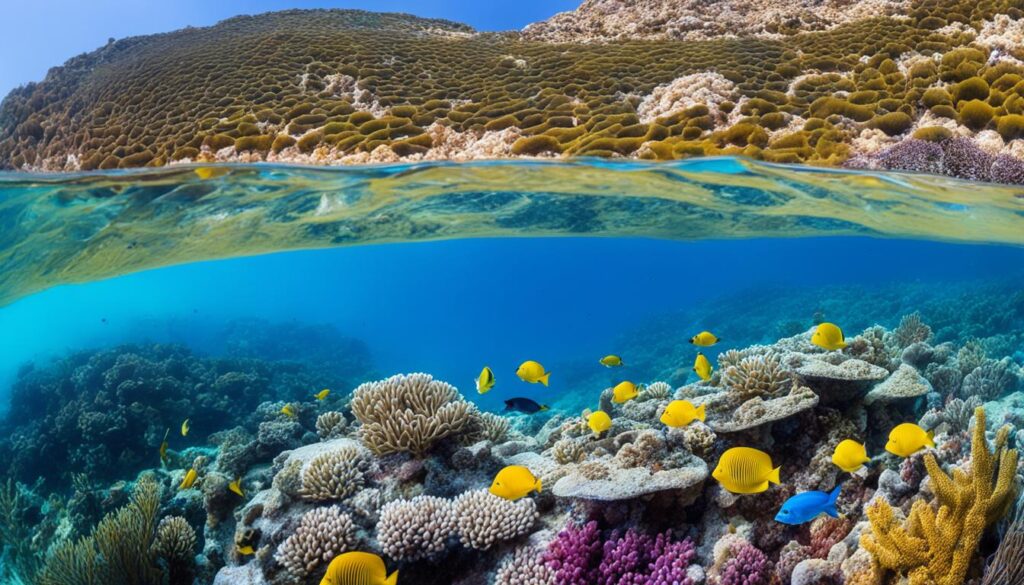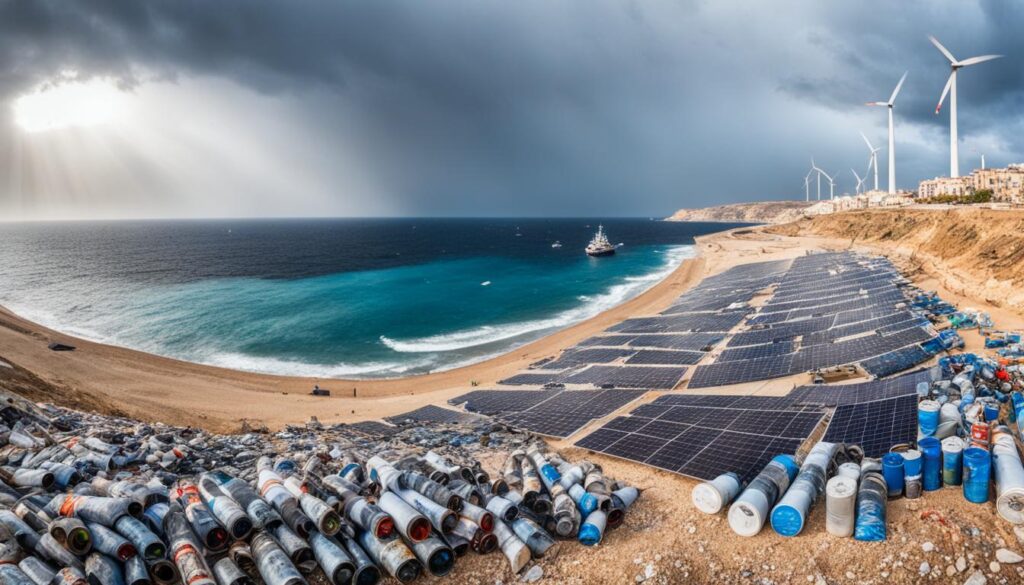The1 Mediterranean region is home to 542 million people1. It’s warming 20% faster than the rest of the world1. This raises big concerns about the effects of climate change on the region’s ecosystems, farms, and communities. Heat waves, drought, extreme weather, and rising sea levels are big challenges ahead1.
Temperatures in the Mediterranean are rising faster than the global average by about 20%1. The region might see a warming of more than 2°C (3.6°F) by the end of the century1. If we don’t cut down on carbon dioxide and other greenhouse gases, these problems could get worse.
Dealing with climate change and adapting to it is hard because of the Mediterranean’s diverse countries, cultures, and economic levels. This leads to big differences in how vulnerable people are across the region. The Mediterranean Sea is huge, covering almost 2.6 million km2 and making up 6.5 percent of the world’s land2. It’s surrounded by 23 countries and has around 480 million people, which is 7.3 percent of the world’s population in 20152. The region’s GDP was 10.4 percent of the global GDP in 20162. But, its delicate ecosystems and resources are under threat as climate change gets worse.
Key Takeaways
- The Mediterranean region is warming 20% faster than the global average.
- Temperatures in the Mediterranean are rising about 20% quicker than the world as a whole.
- The Mediterranean region could experience a warming of more than 2°C (3.6°F) by the end of the century.
- Climate change impacts like heat waves, drought, and sea-level rise pose significant threats to the region’s ecosystems, agriculture, and communities.
- Mitigating climate change and adapting to its effects is complicated by the region’s diversity of countries, cultures, and socioeconomic conditions.
Mediterranean Region Warming Faster Than Global Average
The Mediterranean region is warming at an alarming rate, beating the global average by a lot34. In fact, it’s warming 20% faster than the rest of the world34. This has already led to a 1.5°C rise in temperatures compared to before. By the end of the century, it could go up by up to 6.5°C4.
This fast warming is because of the Mediterranean’s location between three continents that absorb heat3. This means the region’s over 540 million people will face a tough climate change. They’ll also deal with issues like less biodiversity, pollution, dryness, and land degradation3.
Temperatures Rising 20% Quicker Than World as a Whole
The Mediterranean’s temperature is going up 20% faster than the world’s average34. So, while the world is warming, the Mediterranean is warming even more. Temperatures are already 1.5°C higher than before. And they could rise by up to 6.5°C by the end of the century4.
Heat Waves, Drought, Extreme Weather, and Sea Level Rise Expected
The fast warming in the Mediterranean is causing more climate challenges35. Expect more heat waves, long droughts, and extreme weather5. Sea levels are also expected to rise, by 20 to 110 cm by the end of the century3.
“The Mediterranean region is rapidly becoming a major emitter of greenhouse gases at the global scale, overtaking the European Union.”
Even though the Mediterranean only makes up 6% of global greenhouse gas emissions4, its fast warming and climate impacts are big challenges. The region’s people and ecosystems need help to adapt. We must work together to fight climate change and protect the mediterranean climate change5.
Complex Convergence of Environmental and Societal Changes
The Mediterranean region is facing a perfect storm of environmental challenges. Climate change is mixing with issues like biodiversity loss and soil degradation6. These issues are making the region more vulnerable, affecting both nature and people6.
Climate Change Interacting with Other Planetary Boundaries
Climate change is one of nine “planetary boundaries” being crossed, upsetting natural processes6. In the Mediterranean, it shows up in rising temperatures, sea levels, and extreme weather. It’s also linking with biodiversity loss and soil degradation6.
Unsustainable Agricultural Practices Contributing to Environmental Stress
Unsustainable farming is adding to the problem6. The Mediterranean’s farms have changed the region’s balance, making it less resilient6. This, with climate change, is stressing the environment and natural resources6.
These changes are making the Mediterranean’s environmental issues worse. They affect ecosystems, economies, and communities6. Fixing this will need a mix of science and local knowledge6.
“Desertification and climate change, both individually and in combination, will reduce the provision of dryland ecosystem services and lower ecosystem health, causing reductions in crop and livestock productivity and modifying the composition of plant species.”6
The Mediterranean is facing big environmental and societal changes. Its ability to bounce back will be tested6. Solving these complex issues is key to protecting this important region6.
global warming and mediterranean coasts desertification
The Mediterranean region is facing a worrying situation. The Earth’s climate is warming faster here than anywhere else, by 20%7. This rapid warming threatens the ecosystems and communities in the Mediterranean. It could turn vast areas of southern Spain into deserts7.
Research shows that a 2°C rise in global temperatures could happen by 2100 in the Mediterranean7. This would push the southern deserts of Morocco north, replace temperate forests, and expand deserts in the Middle East7.
The Mediterranean has warmed by 1.3°C since the late 19th century, faster than the world average7. It’s home to over 466 million people and provides essential services like clean water and flood protection7. To keep its ecosystem, warming must be limited to 1.5°C, a goal within the region’s natural range7.
Desertification in the Mediterranean is real and happening now. 30% of the semi-arid Mediterranean drylands are already affected, and nearly half the region’s population faces its effects8. The problem is worsened by the fact that drylands cover 61.3% of Southern and Eastern Mediterranean countries, and only 5% of land is used for agriculture in the MENA region, excluding Turkey8.
The Mediterranean’s ecosystems face threats from soil degradation, with high erosion rates and low soil organic matter9. 25% of the EU’s Mediterranean land is at high or very high risk of desertification, due to factors like soil contamination and construction9.
The Mediterranean’s future is uncertain as climate change and human actions combine to change its landscapes. We need urgent action to protect the natural beauty and resources of the Mediterranean for its people and the world.
Increased Flooding and Erosion Risks
The Mediterranean region is expected to get drier overall due to climate change. But, it will see more winter rain. This could cause floods, mudslides, and severe soil erosion, taking away important nutrients from croplands10. In fact, extreme weather events like the 2016 Seine River flood in France could happen twice as often10.
Concentrated Winter Rainfall Could Trigger Mudslides and Soil Loss
The trend of drier summers and wetter winters is worrying for the Mediterranean10. Rainfall might go down yearly, but intense winter storms are expected10. These heavy rains can cause landslides and erosion, taking away the topsoil10.
Already, the loss of nutrients like nitrogen and phosphorus from soil erosion is huge, at about 42 million and 26 million tonnes a year, respectively10. As climate change worsens, the Mediterranean’s farming could be in big trouble10.
Things like overgrazing, cutting down trees, farming too much, and bad irrigation are making the region dry out10. More extreme weather could make things worse, harming ecosystems and causing soil loss10. We need to tackle these issues to protect the Mediterranean’s farms10.
| Metric | Value |
|---|---|
| People Threatened by Desertification | Around 2 billion10 |
| Drylands as % of Earth’s Land Area | Approximately 38%10 |
| People Living in Drylands | About 90% of 2.7 billion10 |
| Annual Global Losses of Nitrogen Due to Soil Erosion | Approximately 42 million tonnes10 |
| Annual Global Losses of Phosphorus Due to Soil Erosion | Around 26 million tonnes10 |
“Desertification is often the result of multiple interacting causes, including climate-related fluctuations and human activities such as deforestation.”10
Sea Level Rise Threatening Coastal Settlements
The Mediterranean Sea has risen by 6 cm in the last 20 years, and this trend is getting worse11. This rise threatens the homes of 42 million people, who live in 37% of the Mediterranean coastline11. It also puts at risk the important wetlands along the coast11.
Sea level rise is a global problem, not just in the Mediterranean. The UN says over 680 million people in low-lying areas could lose their homes and livelihoods11. The 2018 Boe Declaration sees climate change as the top threat to the Pacific’s security and well-being11.
Small island nations are worried about conflicts over resources and the big move of people due to sea-level rise11. The International Law Commission is looking into how rising sea levels affect international law11. They’re concerned about fights over resources, people moving, and losing land and territory11.
Small island nations are finding ways to deal with sea-level rise, like planning for migration with dignity11. The UN Secretary-General warns of big population moves because of rising seas, affecting places from the Caribbean to North Africa11.
The US has promised not to question maritime zones, even if they don’t match the sea level today11. They’re asking countries to cut greenhouse gas emissions and keep their climate promises to fight sea-level rise11.
Sea-level rise affects more than just the Mediterranean. In India, 1.4 billion people live near the coast, facing threats from rising sea levels12. The country has a long coastline, affected by the Bay of Bengal, Indian Ocean, and Arabian Sea12. Over the past 20 years, temperatures have gone up by 0.2°C, and it’s expected to get even hotter12.
The MENA region is also facing big challenges. Climate change and less rain will reduce the region’s water by about 4 percent by 205013. By 2025, 80 to 90 million people in the MENA will face water stress13. Temperatures are set to rise by at least 4°C by 2050, with more heat waves13.
Climate change is having a huge impact on coastal areas, needing urgent action and global cooperation to solve this big problem.
Heat Waves and Marine Ecosystem Impacts
The Mediterranean region is feeling the effects of climate change in its marine ecosystems too. As the Mediterranean waters warm up, they are hurting the region’s fisheries and shellfish populations14. In fact, if global warming goes over 1.5°C, olive yields in the northern Mediterranean could drop by 20%14. Heatwaves in the eastern Mediterranean have gotten much worse, happening six or seven times more often since the 1960s14.
Rising temperatures are affecting marine life in the region14. If global warming goes over 1.5°C, over 20% of the fish and invertebrates in the Eastern Mediterranean could disappear by 206014. Fishing in the Mediterranean could lose up to 30% of its value by 2050 because of climate change’s effects on the sea14. Since the 1980s, invasive species have been harming the Mediterranean’s marine life, causing a loss of biodiversity and species14.
Warmer Waters Harming Fisheries and Shellfish Populations
The warming of the Mediterranean’s waters is a big worry for its marine life15. Since 2014, more than half of the world’s ocean has seen extreme heat, with 57% of the ocean experiencing it in 201915. This rise in ocean temperatures is making it hard for marine ecosystems to support coastal communities15.
These warmer waters are already affecting the region’s fisheries and shellfish populations14. With a global temperature increase of over 1.1°C since the 19th century14, the Mediterranean’s marine life is finding it hard to adapt. This leads to declines in key species and threatens the livelihoods that depend on them14.

“The Monterey Bay Aquarium has pointed out the threat of climate-change-induced extreme heat waves to marine ecosystems, jeopardizing their ability to provide resources for coastal communities.”15
The Mediterranean is warming up faster than the rest of the world14. Its marine ecosystems are facing a tough future. We need to take urgent action to fight climate change and protect these vital marine habitats.
Climate Change Exceeding Global Rates Despite Low Emissions
The Mediterranean region is known for its beautiful landscapes and mild climate. But, it’s facing a big problem: its climate is warming 20% faster than the world average. This is despite it only producing less than 6% of the world’s greenhouse gases16. This fast warming is due to its location between three continents and other natural factors that make it more vulnerable to climate change.
Even though the Mediterranean doesn’t emit much greenhouse gases, it’s feeling the effects of climate change more than others16. This shows how complex and connected our climate system is. Local and regional factors can make the effects of greenhouse gases worse.
The Mediterranean is warming up faster, which is bad news for its ecosystems, farms, and people. As the climate changes, the region will see more heat waves, droughts, and extreme weather. These changes will put a big strain on its resources and buildings16. It’s important to understand why the Mediterranean is warming up so fast to find ways to deal with it.
“Less than 4% of dryland areas are projected to desertify despite increased aridity under climate change, highlighting the complex interplay of factors driving desertification in the Mediterranean.”16
The Mediterranean’s climate change problems are made worse by things like bad farming, not enough water, and a growing population17. To fix these issues, we need a big effort from everyone. This means working together between policymakers, scientists, and local communities to protect the Mediterranean.
Projected Growth in Energy Demand Driving Emissions
The Mediterranean region is facing a big challenge. Its population and economy are growing fast, which will double energy demand and increase carbon dioxide emissions by 45% by 204018. This increase is mainly because southern Mediterranean countries rely a lot on fossil fuels for power and more people are using air conditioning and appliances18.
The Mediterranean Sea covers 6.5 percent of the world’s land and has a 46,000 km coastline, touching 23 countries2. In 2015, 480 million people lived there, making up 7.3 percent of the world’s population2. The region added 10.4 percent to the global GDP in 20162.
Climate change is already affecting the Mediterranean, with temperatures about 1.5°C higher than the global average2. Temperatures have risen by 1.5 to 4°C in some areas since the late 19th century2. Sea surface temperatures have gone up by 0.4°C each year recently2.
It’s important to address the increase in energy use and emissions to protect the Mediterranean from future climate impacts18. Energy consumption in southern Mediterranean countries is set to double by 2040, with electricity use tripling due to more cooling and appliances2. Carbon dioxide emissions are expected to rise by 45%, with a big increase in the southern Mediterranean2. Currently, the Mediterranean’s carbon emissions make up 6 percent of global emissions, but this could go up with more energy use182.
We need investments from everyone to reduce greenhouse gas emissions and adapt to climate change18. Working together on energy markets and cooperation can help find cost-effective solutions18.

Agricultural and Water Resource Challenges
Climate change is making water scarcity worse in the Mediterranean. Evaporation goes up and rainfall goes down, putting pressure on water systems19. The OECD says 40 percent of the world’s people live in areas with not enough water. By 2050, water demand will go up by 55 percent19.
The Mediterranean has 427 million people, which is seven percent of the world’s population19. Most of the water is in the north, but the south has very little19. Agriculture uses a lot of water, which is a big problem for the region.
Agriculture uses most of the water in many places, leading to a 50 percent water gap for food security19. The need for water has doubled in 50 years because of more people and water-using activities like tourism19. We need more than just technical fixes to solve the water problem19.
Some rivers in the Mediterranean are shared by countries, causing tensions over water19.
Water Scarcity Exacerbated by Climate Change and Irrigation Demands
By 2030, the MENA region will have less water per person, below the critical level20. Over 60% of people in the MENA live in areas with high water stress, more than the world average20. Climate change could lead to big economic losses, up to 14% of GDP by 205020.
Fixing the problems with agriculture and water is key to the Mediterranean’s future.
FAQ
What is the rate of warming in the Mediterranean region compared to the global average?
What are some of the key climate impacts expected in the Mediterranean region?
How is climate change interacting with other environmental issues in the Mediterranean?
What could happen if warming exceeds 2°C in the Mediterranean?
How could increased winter rainfall impact the Mediterranean?
How is sea level rise affecting the Mediterranean coastline?
What are the impacts of warmer ocean temperatures in the Mediterranean?
Why is the Mediterranean warming faster than the global average?
How is the Mediterranean’s projected energy demand and emissions growth expected to impact the region?
How is climate change exacerbating water scarcity in the Mediterranean?
Source Links
- Cradle of transformation: The Mediterranean and climate change
- Climate Change in the Mediterranean: Environmental Impacts and Extreme Events
- Climate Migration in the Eye of the Storm: A Future Challenge for the Mediterranean Region
- “Climate change happens 20% faster in the Mediterranean” – Polytechnique Insights
- Overall warming of up to 5°C in this century projected for the Eastern Mediterranean and Middle East
- Desertification — Special Report on Climate Change and Land
- Rapidly Warming Mediterranean Headed for Desertification, Study Warns – Inside Climate News
- Desertification in the Mediterranean Region
- Risk of soil degradation and desertification in Europe’s Mediterranean may be more serious than realized
- Explainer: Desertification and the role of climate change
- Climate Change-induced Sea-Level Rise Direct Threat to Millions around World, Secretary-General Tells Security Council
- Long-term impacts of climate change on coastal and transitional eco-systems in India: an overview of its current status, future projections, solutions, and policies
- Cascading Climate Effects in the Middle East and North Africa: Adapting Through Inclusive Governance
- Heat-struck Mediterranean is climate change ‘hot spot’
- Ocean and Climate Change
- Anthropogenic climate change has driven over 5 million km2 of drylands towards desertification – Nature Communications
- Special Report on Climate Change and Land — IPCC site
- Microsoft Word – 3.3 Energy.docx
- Water Challenges in the Mediterranean
- Ecological Security Threats in North Africa for 2040: Water Scarcity and Desertification – The Council on Strategic Risks

